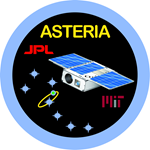ASTERIA Data at the Exoplanet Archive
Project Overview
ASTERIA, the Arcsecond Space Telescope Enabling Research In Astrophysics, is a small spacecraft designed to demonstrate enabling technologies for high-precision space-based photometry from small platforms. ASTERIA is a 6U CubeSat with dimensions 239 mm x 116 mm x 366 mm, and mass of 10.2 kg. ASTERIA carried a small refractive telescope (f/1.4, ~85 mm).

ASTERIA was launched as cargo to the International Space Station (ISS) in August 2017 and deployed into space from ISS on November 20, 2017. The three-month prime mission ended in February 2018 with the successful verification of all technology demonstration requirements. ASTERIA operations continued through several extended missions for a total of two years (eight times its nominal mission lifetime) until loss of contact in December 2019. During this time, ASTERIA conducted a number of onboard experiments and observing campaigns, including observations of known and potential transiting exoplanet host stars.
ASTERIA used a 2592 x 2192 pixel visible light CMOS detector with a plate scale of ~15 arcsec/pixel. The full field of view of the detector is 9.6 x 11.2 degrees. ASTERIA's camera is deliberately defocused in order to oversample the PSF. No color filter was installed; observations are broadband white visible light (500-900 nm).
Data Holdings
Each ASTERIA FITS file is a 64px by 64px by 8-window FITS cube, with a 1-minute typical total integration time. Fine pointing control used the science camera as the guider; hence, eight 64x64 repositionable subarrays were read out at 50ms framerate, rather than full images. The science target was centered in one window, with the other 7 windows placed on guide stars and/or calibration regions. To reduce downlinked data volume, 1200 exposures were typically coadded to create 1-minute cadence images of each window. Metadata and spacecraft housekeeping data can be found in the FITS header (full listing in data guide).
Light curve data are available as a .csv file for all 55 Cancri observations made by ASTERIA (Knapp et al., 2020). Please see the ASTERIA data guide and Knapp et al., 2020 for further information regarding data processing and format.
| Data Set | Download Link | Approx. Download Size | Description |
|---|---|---|---|
| HD 219134 | ASTERIA_HD219134.tar | 1.2 GB | Tar archive file containing FITS image data. See included README.txt for description of contents. |
| 55 Cnc | ASTERIA_55Cnc.tar | 184 MB | Tar archive file containing all FITS images. See included README.txt for description of contents. |
| ASTERIA_55Cnc_lightcurve_transitmodel.csv | 75 KB | Light curve with transit model fit | |
| ASTERIA_55Cnc_lightcurve_notransitmodel.csv | 67 KB | Light curve with no transit model (straight-line fit). |
Request for Acknowledgement
The ASTERIA project was a collaboration between JPL and the Massachusetts Institute of Technology (MIT) and was funded at JPL through the Phaeton Program for training early-career employees. Please cite Knapp et al., 2020.
Additional Project Resources
- JPL ASTERIA website
- Knapp, M. et al. "Demonstrating High-Precision Photometry with a CubeSat: ASTERIA Observations of 55 Cancri e," Astronomical Journal, 160, 23 (2020). Download from AJ, arXiv, or ADS.
- Pong, C. M., Smith, M.W., "Camera Modeling, Centroiding Performance, and Geometric Camera Calibration on ASTERIA," 2019 IEEE Aerospace Conference, Big Sky, MT, March 2019, https://doi.org/10.1109/AERO.2019.8741842
- Knapp, M., et al., "ASTERIA: A CubeSat Enabling High Precision Photometry in a Small Package," 42nd COSPAR Scientific Assembly, Pasadena, CA, July 2018, E4.1-0004-18
- Seager, S. et al., "HD 219134 Revisited: Planet d Transit Upper Limit and Planet f Transit Nondetection with ASTERIA and TESS," Astronomical Journal, 161, 3 (2021)
Last updated: 22 September 2022




